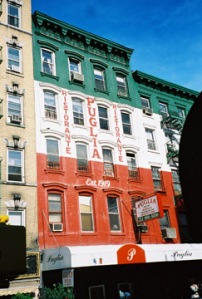[From the National Trust website]
Every year, the National Trust for Historic Preservation releases a list of America’s 11 Most Endangered Historic Places. Since 1988 the list has drawn attention to such landmarks as Congressional Cemetery in Washington, D.C., and the TWA Terminal at New York City’s JFK International Airport. The following highlights this year’s “11 Most”—the beloved and significant sites across the country in serious jeopardy.
Vizcaya and Bonnet House, Miami and Fort Lauderdale, FL

Bonnet House Museum & Gardens is fighting construction of an 18-story hotel that would forever mar views from the estate.
Though separated by just 30 miles, Miami’s Vizcaya and Fort Lauderdale’s Bonnet House are both threatened by encroaching development.
A proposed high-rise condominium project would mar Vizcaya’s view, spoil the estate gardens, and adversely affect the single-family neighborhoods nearby. At Bonnet House, massive buildings already intrude upon view corridors. Now a developer has received permission to build an 18-story hotel less than 200 feet away.
Both homes are historic treasures. Industrialist James Deering built Vizcaya between 1914 and 1916 as a winter residence. His Renaissance villa is a National Historic Landmark, celebrated for its palatial Italianate main house, 10 acres of formal gardens, and native hardwood forest. The property includes a bamboo bar, a shell museum, and an aviary, as well as gardens that are home to monkeys, swans, and the occasional manatee.
Michigan Avenue Streetwall, Chicago, IL
The west side of central Michigan Avenue is home to structures so visible and iconic that residents call the stretch Chicago’s front door. The “streetwall’s” historic character is now threatened by the inappropriate addition of large towers that would retain only small portions of the original buildings or their facades.
The Lower East Side, New York City
This storied enclave below Delancey Street, once home to thousands of immigrant families, retains a remarkable collection of historic buildings and landmarks. In recent years, an influx of high-rises has threatened the district’s distinctive streetscapes, known for their unusual mix of Federal row houses, tenements, and bodegas. New York City officials will have to designate the Lower East Side a city landmark to prevent further losses and destruction.
Charity Hospital and the adjacent neighborhood, New Orleans, LA
A 1939 art deco landmark, Charity Hospital has been shuttered since Hurricane Katrina, when levees failed and floodwaters inundated New Orleans. The Louisiana State University medical system deemed the hospital unsafe and endorsed the construction of a new facility alongside a proposed VA hospital. (That would require the demolition of countless historic houses in the neighborhood.) But preservationists argue that Charity can be repaired and reopened to provide services for the poor.
The Statler Hilton, Dallas, TX

The interior of the Statler Hilton Hotel in Dallas, Texas, is falling into disrepair.
A midcentury modern landmark, the 1956 Statler was the first glass-and-metal hotel in the nation. The building has been vacant since 2001, and no buyers have come forward—in part because of a $20 million price tag and extensive asbestos contamination. Barring an innovative proposal for reuse, the hotel will likely be demolished.
Sumner Elementary School, Topeka, KS
In 1950, Oliver Brown walked the seven blocks from his home to Sumner Elementary School and attempted to enroll his eight-year-old daughter, Linda. Because Topeka’s schools were segregated, Brown was turned away; he then became lead plaintiff in the 1954 Supreme Court decision Brown v. Board of Education. Today, the vacant school building, a National Historic Landmark, has fallen into serious disrepair despite the city’s pledge to protect it. Topeka’s city council has already authorized its demolition.
Great Falls Portage, Great Falls, MT
The site of Lewis and Clark’s portage at Great Falls—one of the most difficult ordeals on their westward journey—has remained largely unchanged since 1805. Now the construction of an enormous coal-fired power plant threatens this National Historic Landmark. (See the story in Preservation’s July/August 2007 issue.) The new generating facility, which will likely include a 400-foot smokestack and several 26-story wind turbines, would alter one of the best-preserved landscapes on the Lewis and Clark Trail.
Boyd Theatre, Philadelphia, PA

The last "real" movie theater was built the year before the great stock market crash of 1929
The 1928 art deco theater, built with a towering vertical sign and dramatic mirrored lobby, is the last surviving motion picture palace in downtown Philadelphia. Once host to premieres with Grace Kelly and Tom Hanks, the Boyd has remained vacant since 2002. Unless a sympathetic buyer renovates this landmark, it will remain vulnerable to demolition. To help save it, go to Friends of the Boyd.
California State Parks, CA
California’s state park system is one of the country’s largest and most successful. Unfortunately, the system remains drastically underfunded and at risk of deterioration—a result of more than $1 billion in deferred maintenance. Gov. Arnold Schwarzenegger’s proposal to increase user fees for park visitors would do little to remedy this dire situation.
Peace Bridge Neighborhood, Buffalo, NY
More than 100 houses in a community with parks designed by Frederick Law Olmsted and buildings dating to the 1850’s — may be razed to expand the Peace Bridge complex. (The span connects Buffalo to Canada.) Preservationists argue that existing bridges could accommodate traffic, and a truck plaza, without destroying historic neighborhoods.
Hangar One, Moffett Field, Santa Clara County, CA
Built by the U.S. Navy in 1932 to house dirigibles, Hangar One remains one of the largest aircraft hangars in the world. However, Hangar One’s outdated siding and other materials are leaking toxic PCBs, rendering the dome-shaped structure unusable unless current owner NASA undertakes a rehab effort to remove the environmental pollutants.
Know of a place that needs saving? Nominate it!



